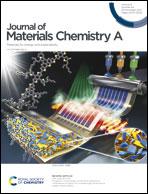Conductive two-dimensional M3(C6S3O3)2 monolayers as effective electrocatalysts for the oxygen reduction reaction†
Abstract
Two-dimensional (2D) conjugated metal–organic frameworks (MOFs) which feature single atom catalysts are promising electrocatalysts to promote the oxygen reduction reaction (ORR). Here, by means of density functional theory calculations and microkinetics simulations, we designed a new type of 2D MOFs namely monolayers of M3(C6S3O3)2 (M = Cr, Mn, Fe, Co, Ni, Cu, Pd, Rh and Ru) and explored their potential as electrocatalysts for the ORR. All 2D M3(C6S3O3)2 monolayers are metallic because of the effective orbital coupling between the π-conjugated organic linkers (1,3,5-trihydroxybenzene-2,4,6-trithiol) and the central metals. The designed structures show good catalytic activities because of the synergistic effect provided by the hybrid organic linkers, and the catalytic performance can be tuned by changing the central metals. Among them, Rh3(C6S3O3)2 outperforms Pt/C by showing a large limiting potential of 0.81 V, while Co3(C6S3O3)2, Fe3(C6S3O3)2 and Mn3(C6S3O3)2 show comparable ORR catalytic activity to Pt/C. Our study provides a new clue for the design of functional 2D MOFs as effective catalysts for the ORR.



 Please wait while we load your content...
Please wait while we load your content...